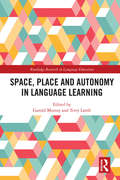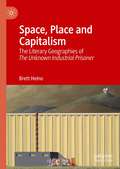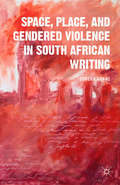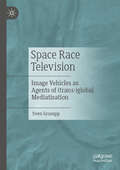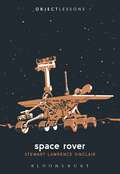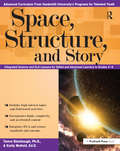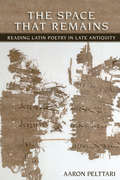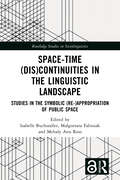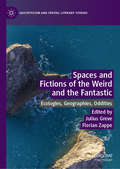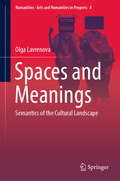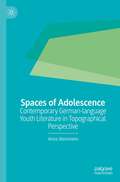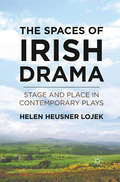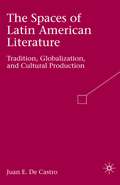- Table View
- List View
Space, Place and Autonomy in Language Learning (Routledge Research in Language Education)
This book explores theories of space and place in relation to autonomy in language learning. Encompassing a wide range of linguistically and culturally diverse learning contexts, this edited collection brings together research papers from academics working in fourteen countries. In their studies, these researchers examine physical, virtual and metaphorical learning spaces from a wide range of theoretical and interdisciplinary perspectives (semiotic, ecological, complexity, human geography, linguistic landscapes, mediated discourse analysis, sociocultural, constructivist and social constructivist) and methodological approaches. The book traces its origins to the first-ever symposium on space, place and autonomy, which was held at the International Association of Applied Linguistics (AILA) 2014 World Congress in Brisbane. The final chapter, which presents a thematic analysis of the papers in this volume, discusses the implications for theory development, further enquiry, and pedagogical practice.
Space, Place and Capitalism: The Literary Geographies of The Unknown Industrial Prisoner
by Brett HeinoThis book is an original contribution to literary geography and commentaries on the work of David Ireland. It plots the relationship between the spaces and places of 1970s Australian capitalism as it evolves through Ireland’s 1971 Miles Franklin prize-winning novel The Unknown Industrial Prisoner. In particular, the book theorises the relationship between space and place in literature through two highly innovative arguments: a focus on the spatial unconscious as a means to assess and track the spatiality of capitalism in the novel form; and the articulation of a regime of space through the perceived, conceived and lived constitution of space. Drawing together concepts from radical geography and structural Marxist literary theory, it explores the dominance of the regime of abstract space in the Australian context. The text also examines the nature and possibilities of place-based strategies of resistance, and concludes by suggesting opportunities for future research and plotting the ways in which The Unknown Industrial Prisoner continues to speak to contemporary Australia.
Space, Place, and Gendered Violence in South African Writing
by S. GunneExploring the relationship between space, place, and gendered violence as depicted in a range of South African writing, Gunne examines the social and political conditions of exceptionality during and after apartheid. Writers covered include: Hilda Bernstein, J.M. Coetzee, Achmat Dangor, Ruth First, Nadine Gordimer, and Antjie Krog.
Space, Place and Poetry in English and German, 1960–1975 (Geocriticism and Spatial Literary Studies)
by Nicola ThomasSpace, Place and Poetry in English and German, 1960-1975 examines the work of Paul Celan, J. H. Prynne, Derek Mahon, Sarah Kirsch, Edwin Morgan and Ernst Jandl, bringing together postwar English- and German-language poetry and criticism on the theme of space, place and landscape. Nicola Thomas highlights hitherto underexplored connections between a wide range of poets working across the two language areas, demonstrating that space and place are vital critical categories for understanding poetry of this period. Thomas’s analysis reveals weaknesses in existing critical taxonomies, arguing for the use of ‘late modernist’ as a category with cross-cultural relevance, and promotes methodological exchange between the Anglophone and German traditions of landscape, space and place oriented poetic criticism, to the benefit of both.
Space, Place and Poetry in English and German, 1960–1975 (Geocriticism and Spatial Literary Studies)
by Nicola ThomasSpace, Place and Poetry in English and German, 1960-1975 examines the work of Paul Celan, J. H. Prynne, Derek Mahon, Sarah Kirsch, Edwin Morgan and Ernst Jandl, bringing together postwar English- and German-language poetry and criticism on the theme of space, place and landscape. Nicola Thomas highlights hitherto underexplored connections between a wide range of poets working across the two language areas, demonstrating that space and place are vital critical categories for understanding poetry of this period. Thomas’s analysis reveals weaknesses in existing critical taxonomies, arguing for the use of ‘late modernist’ as a category with cross-cultural relevance, and promotes methodological exchange between the Anglophone and German traditions of landscape, space and place oriented poetic criticism, to the benefit of both.
Space Race Television: Image Vehicles as Agents of (trans-)global Mediatisation
by Sven GramppThis volume offers a media-theoretically oriented perspective on the Space Race. It analyzes feature films, documentaries, live television coverage, magazines, stamps, posters, ticker-tape parades. They visualized the Space Race in a specific way and circulated it transnationally from 'East' to 'West' and from 'West' to 'East' across the 'Iron Curtain'. It will be shown how reporting on the Space Race between 1955 and 1975 can be explained as a globalizing history of the intertwining of images during the Cold War.
Space Rover (Object Lessons)
by Prof. Stewart Lawrence SinclairObject Lessons is a series of short, beautifully designed books about the hidden lives of ordinary things.In 1971, the first lunar rover arrived on the moon. The design became an icon of American ingenuity and the adventurous spirit and vision many equated with the space race.Fifty years later, that vision feels like a nostalgic fantasy, but the lunar rover's legacy paved the way for Mars rovers like Sojourner, Curiosity, and Perseverance. Other rovers have made accessible the world's deepest caves and most remote tundra, extending our exploratory range without risking lives. Still others have been utilized for search and rescue missions or in clean up operations after disasters such as Chernobyl. For all these achievements, rovers embody not just our potential, but our limits. Examining rovers as they wander our terrestrial and celestial boundaries, we might better comprehend our place, and fate, in this universe. Object Lessons is published in partnership with an essay series in The Atlantic.
Space Rover (Object Lessons)
by Prof. Stewart Lawrence SinclairObject Lessons is a series of short, beautifully designed books about the hidden lives of ordinary things.In 1971, the first lunar rover arrived on the moon. The design became an icon of American ingenuity and the adventurous spirit and vision many equated with the space race.Fifty years later, that vision feels like a nostalgic fantasy, but the lunar rover's legacy paved the way for Mars rovers like Sojourner, Curiosity, and Perseverance. Other rovers have made accessible the world's deepest caves and most remote tundra, extending our exploratory range without risking lives. Still others have been utilized for search and rescue missions or in clean up operations after disasters such as Chernobyl. For all these achievements, rovers embody not just our potential, but our limits. Examining rovers as they wander our terrestrial and celestial boundaries, we might better comprehend our place, and fate, in this universe. Object Lessons is published in partnership with an essay series in The Atlantic.
Space, Structure, and Story: Integrated Science and ELA Lessons for Gifted and Advanced Learners in Grades 4-6
by Tamra Stambaugh Emily MofieldWinner of the 2017 NAGC Curriculum Studies Award Space, Structure, and Story integrates Earth and space science with science fiction and nonfiction texts, poetry, and art. This unit, developed by Vanderbilt University's Programs for Talented Youth, is aligned to the Common Core State Standards and Next Generation Science Standards. Students explore advanced science and ELA content through the lens of structure—its parts, purpose, and function. Mobius strips, the hero's journey, dystopian fiction, black holes, Einstein's relativity, stars, and moons are just a few of the captivating in-depth topics explored through accelerated content, engaging activities, and differentiated tasks. Ideal for gifted classrooms or gifted pull-out groups, the unit features poetry from Carl Sandburg, Henry Wadsworth Longfellow, and C. S. Lewis; art from M. C. Escher, Vincent Van Gogh, Claude Monet, and Salvador Dali; a novel study featuring A Wrinkle in Time by Madeleine L'Engle; short stories from Isaac Asimov and Ray Bradbury; speeches from President John F. Kennedy and President Barack Obama; and informational texts about gravity, orbits, and black holes. Grades 4-6
Space, Structure, and Story: Integrated Science and ELA Lessons for Gifted and Advanced Learners in Grades 4-6
by Tamra Stambaugh Emily MofieldWinner of the 2017 NAGC Curriculum Studies Award Space, Structure, and Story integrates Earth and space science with science fiction and nonfiction texts, poetry, and art. This unit, developed by Vanderbilt University's Programs for Talented Youth, is aligned to the Common Core State Standards and Next Generation Science Standards. Students explore advanced science and ELA content through the lens of structure—its parts, purpose, and function. Mobius strips, the hero's journey, dystopian fiction, black holes, Einstein's relativity, stars, and moons are just a few of the captivating in-depth topics explored through accelerated content, engaging activities, and differentiated tasks. Ideal for gifted classrooms or gifted pull-out groups, the unit features poetry from Carl Sandburg, Henry Wadsworth Longfellow, and C. S. Lewis; art from M. C. Escher, Vincent Van Gogh, Claude Monet, and Salvador Dali; a novel study featuring A Wrinkle in Time by Madeleine L'Engle; short stories from Isaac Asimov and Ray Bradbury; speeches from President John F. Kennedy and President Barack Obama; and informational texts about gravity, orbits, and black holes. Grades 4-6
The Space That Remains: Reading Latin Poetry in Late Antiquity (Cornell Studies in Classical Philology #64)
by Aaron PelttariIn The Space That Remains, Aaron Pelttari offers the first systematic study of the major fourth-century poets since Michael Robert's foundational The Jeweled Style. It is the first book to give equal attention to both Christian and Pagan poetry and the first to take seriously the issue of readership.As Pelttari shows, the period marked a turn towards forms of writing that privilege the reader's active involvement in shaping the meaning of the text. In the poetry of Ausonius, Claudian, and Prudentius we can see the increasing importance of distinctions between old and new, ancient and modern, forgotten and remembered. The strange traditionalism and verbalism of the day often concealed a desire for immediacy and presence. We can see these changes most clearly in the expectations placed upon readers. The space that remains is the space that the reader comes to inhabit, as would increasingly become the case in the literature of the Latin Middle Ages.
Space-Time: Studies in the Symbolic (Re-)appropriation of Public Space (Routledge Studies in Sociolinguistics)
by Isabelle Buchstaller, Małgorzata Fabiszak, and Melody Ann RossThis collection spotlights the diachronic dimensions of the linguistic landscape, the importance of exploring temporal dissonances in historical events in order to better understand semiotic, political, and social transformations across different communities over the last century.The volume seeks to expand the current borders of linguistic landscape (LL) research by situating the analysis of signs in the LL within their time–space organization, which has been understudied in existing scholarship. The book, featuring chapters from established and emerging scholars, argues that a focus on the historicity of the city text can reveal unique insights into the role of semiotic processes as precursors and support mechanisms for political and social changes. The collection is structured around different temporal clusters and geographic contexts across the globe where shorter and longer waves of politically driven resemioticization can be most sharply observed – post-colonial communities; post-communist societies; and recent and current sociopolitical upheavals. Taken together, the volume proposes a kaleidoscope view of the complex temporalities that underpin multimodal discourses in contested public spaces, offering new directions for LL research.This book will be of interest to students and scholars in sociolinguistics, discourse analysis, semiotics, visual anthropology, and political science.The Introduction and Chapter 8 of this book is freely available as a downloadable Open Access PDF at http://www.taylorfrancis.com under a Creative Commons Attribution-Non Commercial-No Derivatives (CC-BYNC-ND) 4.0 license.
Space-Time: Studies in the Symbolic (Re-)appropriation of Public Space (Routledge Studies in Sociolinguistics)
This collection spotlights the diachronic dimensions of the linguistic landscape, the importance of exploring temporal dissonances in historical events in order to better understand semiotic, political, and social transformations across different communities over the last century.The volume seeks to expand the current borders of linguistic landscape (LL) research by situating the analysis of signs in the LL within their time–space organization, which has been understudied in existing scholarship. The book, featuring chapters from established and emerging scholars, argues that a focus on the historicity of the city text can reveal unique insights into the role of semiotic processes as precursors and support mechanisms for political and social changes. The collection is structured around different temporal clusters and geographic contexts across the globe where shorter and longer waves of politically driven resemioticization can be most sharply observed – post-colonial communities; post-communist societies; and recent and current sociopolitical upheavals. Taken together, the volume proposes a kaleidoscope view of the complex temporalities that underpin multimodal discourses in contested public spaces, offering new directions for LL research.This book will be of interest to students and scholars in sociolinguistics, discourse analysis, semiotics, visual anthropology, and political science.The Introduction and Chapter 8 of this book is freely available as a downloadable Open Access PDF at http://www.taylorfrancis.com under a Creative Commons Attribution-Non Commercial-No Derivatives (CC-BYNC-ND) 4.0 license.
Space, Time and Evaluation in Ideological Discourse
by Laura Filardo-Llamas Christopher Hart Bertie KaalBringing together a body of related research which has recently developed in Critical Discourse Analysis, this book is the first to address the role of perspective in socio-political discourse. Specifically, the contributions to this volume seek to explore, from a cognitive standpoint, the way in which perspective functions in three dimensions – space, time, and evaluation – to enact ideology and persuasion. A range of discourse genres are analysed, including political discourse, media discourse, and songs used as political tools. Starting from the contention that discourse processing relies on the same mechanisms that support our understanding and experience of space, the book finds a recurrent theme in the way in which perspectival concepts like distance and focus, prompted by linguistic signs, feature in our discursively constructed knowledge of social and political realities. By highlighting the complex nature of perspective-taking in ideological discourse, the volume sets the agenda for further research in this area. The book will appeal to linguists, discourse analysts, media scholars, and political scientists, and all who are interested in the relationship between language and cognition in the socio-political domain. This book was originally published as a special issue of Critical Discourse Studies.
Space, Time and Evaluation in Ideological Discourse
by Laura Filardo-Llamas Christopher Hart Bertie KaalBringing together a body of related research which has recently developed in Critical Discourse Analysis, this book is the first to address the role of perspective in socio-political discourse. Specifically, the contributions to this volume seek to explore, from a cognitive standpoint, the way in which perspective functions in three dimensions – space, time, and evaluation – to enact ideology and persuasion. A range of discourse genres are analysed, including political discourse, media discourse, and songs used as political tools. Starting from the contention that discourse processing relies on the same mechanisms that support our understanding and experience of space, the book finds a recurrent theme in the way in which perspectival concepts like distance and focus, prompted by linguistic signs, feature in our discursively constructed knowledge of social and political realities. By highlighting the complex nature of perspective-taking in ideological discourse, the volume sets the agenda for further research in this area. The book will appeal to linguists, discourse analysts, media scholars, and political scientists, and all who are interested in the relationship between language and cognition in the socio-political domain. This book was originally published as a special issue of Critical Discourse Studies.
Spacecraft (Object Lessons)
by Timothy MortonScience fiction is filled with spacecraft. On Earth, actual rockets explode over Texas while others make their way to Mars. But what are spacecraft, and just what can they teach us about imagination, ecology, democracy, and the nature of objects? Why do certain spacecraft stand out in popular culture?If ever there were a spacecraft that could be detached from its context, sold as toys, turned into Disney rides, parodied, and flit around in everyone's head-the Millennium Falcon would be it. Springing from this infamous Star Wars vehicle, Spacecraft takes readers on an intergalactic journey through science fiction and speculative philosophy, revealing real-world political and ecological lessons along the way. In this book Timothy Morton shows how spacecraft are never mere flights of fancy.
Spacecraft (Object Lessons)
by Timothy MortonScience fiction is filled with spacecraft. On Earth, actual rockets explode over Texas while others make their way to Mars. But what are spacecraft, and just what can they teach us about imagination, ecology, democracy, and the nature of objects? Why do certain spacecraft stand out in popular culture?If ever there were a spacecraft that could be detached from its context, sold as toys, turned into Disney rides, parodied, and flit around in everyone's head-the Millennium Falcon would be it. Springing from this infamous Star Wars vehicle, Spacecraft takes readers on an intergalactic journey through science fiction and speculative philosophy, revealing real-world political and ecological lessons along the way. In this book Timothy Morton shows how spacecraft are never mere flights of fancy.
Spaces and Fictions of the Weird and the Fantastic: Ecologies, Geographies, Oddities (Geocriticism and Spatial Literary Studies)
by Julius Greve Florian ZappeThis collection of essays discusses genre fiction and film within the discursive framework of the environmental humanities and analyses the convergent themes of spatiality, climate change, and related anxieties concerning the future of human affairs, as crucial for any understanding of current forms of “weird” and “fantastic” literature and culture. Given their focus on the culturally marginal, unknown, and “other,” these genres figure as diagnostic modes of storytelling, outlining the latent anxieties and social dynamics that define a culture’s “structure of feeling” at a given historical moment. The contributions in this volume map the long and continuous tradition of weird and fantastic fiction as a seismograph for eco-geographical turmoil from the nineteenth to the twenty-first century, offering innovative and insightful ecocritical readings of H. P. Lovecraft, Harriet Prescott Spofford, China Miéville, N. K. Jemisin, Thomas Ligotti, and Jeff VanderMeer, among others.
Spaces and Meanings: Semantics of the Cultural Landscape (Numanities - Arts and Humanities in Progress #8)
by Olga LavrenovaThis book examines the problem of relationships between culture and space. Highlighting the use of semiotics of culture as a basic concept of research, it describes the power of the cultural landscape in the context of culture philosophical research. Opening with a discussion of the existence of culture in space, it establishes basic concepts such as noosphere and pneumatosphere. The author acknowledges the early contributions of thinkers like Vladimir Vernadsky and Pierre Teilhard de Chardin, who first observed that human activity has become a geological force.Introducing time and space to the discussion, the author then describes the nature of mythological time, eternity versus timelessness, and the semantics of sacred landscapes, space and ritual. These concepts are further developed in discussions of the metaphorical nature of cultural landscape, and the city as metaphor.The book explores semiotics in the cultural landscape, examining the genesis of concepts from geographical images to signs and the axiological dimension of geographical images. In her approach to the idea of cultural landscape as text, she provides detailed examples, including the Russian landscape as agent provocateur of the text, and the culture philosophical aspects and semantics of travel.It establishes the cultural landscape as a phenomenon of culture that is fixed in geographical space with the help of semiotic mechanisms—a specific area of culture of life possessing functional and ontological self-sufficiency.This book appeals readers and researchers interested in the philosophy of culture, semiotics of space, and the philosophical dimensions of culture and geography.
Spaces for Nostalgia: Difficult Memories and Material Consolations (Palgrave Studies in Cultural Heritage and Conflict)
by Mario PanicoHow is nostalgia expressed through space? Studies of nostalgia have long illustrated the emotional dynamics which condition our desire to go back to a time and a space that belong to the past. This book addresses this condition from an innovative perspective, by over-exposing the spatial dimension of nostalgia. Doing so unveils alternative and complementary ways of thinking through how this emotion is activated: in particular, how space – unlike time – can be recreated in the present, even in a different location, with the deliberate aim of consoling this bittersweet sensation. The volume defines this re-creation as a “space for nostalgia”. In this book, this concept is applied within the context of cultural heritage and difficult memories. As a further step, then, the volume questions the modalities through which nostalgia can interact with and permeate a space of memory, therefore influencing collective understandings and the emotional re-writings of our shared pasts. Through case studies relating to challenging nostalgias for troubled pasts in Western Europe, the book examines how the furnishing and use of space, the discourses that surround it, and the objects that become synecdoche of it provide a terrain where even unlikely or troubling forms of nostalgia can grow and blossom.
Spaces for Reading in Later Medieval England (The New Middle Ages)
by Mary C. FlanneryWe are living in an age in which the relationship between reading and space is evolving swiftly. Cutting-edge technologies and developments in the publication and consumption of literature continue to uncover new physical, electronic, and virtual contexts in which reading can take place. In comparison with the accessibility that has accompanied these developments, the medieval reading experience may initially seem limited and restrictive, available only to a literate few or to their listeners; yet attention to the spaces in which medieval reading habits can be traced reveals a far more vibrant picture in which different kinds of spaces provided opportunities for a wide range of interactions with and contributions to the texts being read. Drawing on a rich variety of material, this collection of essays demonstrates that the spaces in which reading took place (or in which reading could take place) in later medieval England directly influenced how and why reading happened.
Spaces of Adolescence: Contemporary German-language Youth Literature in Topographical Perspective
by Anna StemmannAdolescence is a phase of transition, change and upheaval. These processes are often translated into movements through space in literary representations. The narrated space is to be read in its construction and semantics as a complex symbol carrier that is able to connect different dimensions with one another. The study develops, with reference to cultural-scientific spatial theories, a methodical model to analyze current youth novels from a topographical perspective and thus to discuss the interweaving of space, movement and growing up. In the cultural studies and narratological view of (narrative) spaces of adolescence, new trends and developments in youth literature after 2000 manifest themselves. This book is a translation of the original German 1st edition Räume der Adoleszenz by Anna Stemmann, published by J.B. Metzler, part of Springer Nature in 2019. The translation was done with the help of artificial intelligence (machine translation by the service DeepL.com). A subsequent human revision was done primarily in terms of content, so that the book will read stylistically differently from a conventional translation. Springer Nature works continuously to further the development of tools for the production of books and on the related technologies to support the authors.
Spaces of Feeling: Affect and Awareness in Modernist Literature
by Marta FiglerowiczCan other people notice our affects more easily than we do? In Spaces of Feeling, Marta Figlerowicz examines modernist novels and poems that treat this possibility as electrifying, but also deeply disturbing. Their characters and lyric speakers are undone, Figlerowicz posits, by the realization that they depend on others to solve their inward affective conundrums—and that, to these other people, their feelings often do not seem mysterious at all.Spaces of Feeling features close readings of works by Virginia Woolf, James Baldwin, John Ashbery, Ralph Ellison, Marcel Proust, F. Scott Fitzgerald, Sylvia Plath, and Wallace Stevens. Figlerowicz points out that these poets and novelists often place their protagonists in domestic spaces—such as bedrooms, living rooms, and basements—in which their cognitive dependence on other characters inhabiting these spaces becomes clear. Figlerowicz highlights the diversity of aesthetic and sociopolitical contexts in which these affective dependencies become central to these authors' representations of selfhood. By setting these novels and poems in conversation with the work of contemporary theorists, she illuminates pressing and unanswered questions about subjectivity.
The Spaces of Irish Drama: Stage and Place in Contemporary Plays
by H. LojekLojek provides extensive analysis of space in plays by living Irish playwrights, applying practical understandings of staging and the insights of geographers and spatial theorists to drama in an era increasingly aware of space.
The Spaces of Latin American Literature: Tradition, Globalization, and Cultural Production
by Juan E. De CastroThe Spaces of Latin American Literature: Tradition, Globalization, and Cultural Production examines how Latin American writers, artists, and intellectuals have negotiated their relationship with Western culture from the colony to the present. De Castro looks at writers and intellectual polemics that serve as markers of the region's cultural evolution. Among the writers and artists studied are Sor Juana Inés de la Cruz, Rubén Darío, Jorge Luis Borges, Caetano Veloso, and Alberto Fuguet. This book proposes an analysis of the region's literature rooted in its specific cultural, political, and economic locations.
